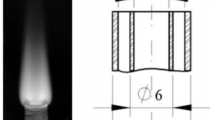Abstract
Measuring the temperature field of the flame of a burning pyrotechnical composition from its infrared radiation is a difficult problem because of the high luminosity and high concentration of the condensed‐phase particles. In the present work, moire deflection tomography was used to measure the instantaneous temperature field during combustion of a pyrotechnical mixture. The boundaries of the burning region were clearly observed. The distribution of the refractive index of the axisymmetric burning region was reconstructed using numerical inversion of the Abel integral equation, and the temperature distribution in the horizontal section was obtained. The maximum value of the flame temperature was determined.
Similar content being viewed by others
REFERENCES
N. Kubota and C. Serizawa, "Combustion process of Mg/TF pyrotechnics," Propell., Explos., Pyrotech., 12, 145-148 (1987).
C. M. Vest, "Interferometry of strong refracting axisymmetric phase objects," Appl. Opt., 14, No. 7, 1601-1606 (1975).
S. R. Deans, Radon and Abel Transforms, CRC Press, Deans (1996).
C. M. Deans, "Tomography for properties of materials that bend rays: A tutorial," Appl. Opt., No. 12, 4089-4094 (1985).
Author information
Authors and Affiliations
Rights and permissions
About this article
Cite this article
Xue, W., Donglou, W. & Gongpei, P. Use of Moire Tomography to Measure the Temperature Field of the Flame of a Pyrotechnical Composition from Its Infrared Radiation. Combustion, Explosion, and Shock Waves 37, 440–442 (2001). https://doi.org/10.1023/A:1017901012998
Issue Date:
DOI: https://doi.org/10.1023/A:1017901012998




